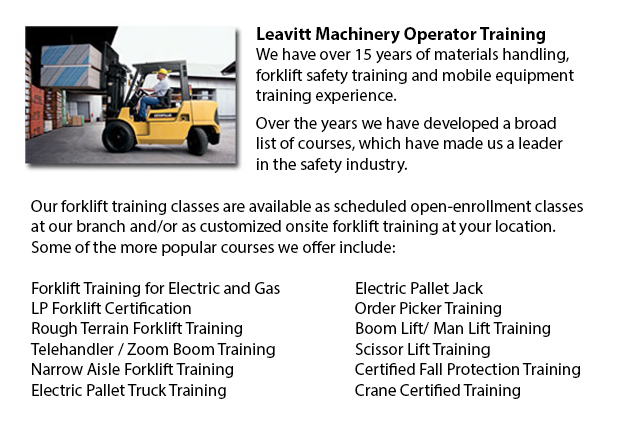
Forklift Training Schools BC - Know How To Use A Forklift Properly With Our Forklift Training Schools
If you are searching for a job as a forklift operator, our regulatory-compliant lift truck training Schools provide excellent instruction in many types and styles of lift trucks, classes on pre-shift check, fuel kinds and handling of fuels, and safe operation of a forklift. Practical, hands-on training assists participants in acquiring basic operational skills. Course content consists of existing regulations governing the utilization of forklifts. Our proven forklift Schools are designed to offer training on these kinds of trucks: narrow isle forklift, counterbalanced forklift and powered pallet truck.
When the lift truck is in operation, do not raise or lower the forks. Loads should not extend over the backrest. This is due to the risk of the load sliding back towards the operator. Inspect for overhead obstructions and ensure there is sufficient clearance prior to lifting a load. Stay away from overhead power lines. Once the load is raised straight up, tilt it back slightly.
The lift truck is less stable when a load is in a raised position. Make sure that no one ever walks underneath the elevated fork. The operator must never leave the lift truck when the load is raised.
When handling pallets, forks must be high and level enough to go into the pallet and extend all the way below the load. The fork's width must provide even weight distribution.
Before loading or unloading the truck, set the brakes and chock the wheels. Floors have to be strong enough to support the weight of the forklift and the load combined. Fixed jacks can be installed to support a semi-trailer that is not attached to a tractor. The height of the entrance door should clear the forklift height by at least 5 cm. Mark edges of rail cars, ramps or docks and avoid them.
-
Zoom Boom Ticket BC
Zoom Boom Ticket BC - Zoom Boom Training focuses on correctly training prospective operators on variable reach forklifts. The training objectives include gaining the understanding of the equipments physics and to be able to define the job of the oper... More -
Scissor Lift Training BC
Scissor Lift Training BC - When operating a scissor lift, they should be used competently in order to protect the wellbeing of the other personnel in the workplace and to protect the safety of the equipment. Operators who are skilled are trained to d... More -
Wheel and Track Loader Training in BC
Lift trucks are obtainable in several load capacities and several models. Nearly all forklifts in a regular warehouse surroundings have load capacities between one to five tons. Bigger scale models are used for heavier loads, like loading shipping co... More -
Zoom Boom Training BC
Zoom Boom Training BC - Zoom Boom Training focuses on properly training prospective operators on variable reach forklifts. The training goals consist of gaining the knowledge of the machine's physics and to define the responsibilities of the operator... More -
Heavy Equipment Operator Certification BC
Heavy Equipment Operator Certification BC - The heavy equipment operator is a person who manipulates the controls and drives various types of huge machinery. Heavy machinery is most commonly used on construction sites to deliver supplies to the site... More -
Crane Ticket BC
Crane Ticket BC - New cranes can either be complex or simple, based on the nature of the application they are able to do. For example, mobile cranes are rather simple models. A steel truss and even a telescopic boom mounts its movable platform. A sys... More -
Telehandler Training in BC
Telescopic handlers normally known as telehandlers for short, are a very popular piece of heavy construction machinery. They are commonly utilized in the construction and agricultural industries. These equipments have maximum reaching capacity and ar... More -
Wheel Loader Training BC
Wheel Loader Training BC - Normally, the various types of heavy equipment training are divided into 2 categories of equipment: those which have rubber tires and tracked vehicles. Tracked vehicles comprise items like excavators, cranes, and bulldozers... More

Forklift Training BC
TOLL FREE: 1-888-254-6157
forkliftcertificationbritishcolumbia.com
Email Us
About Us


